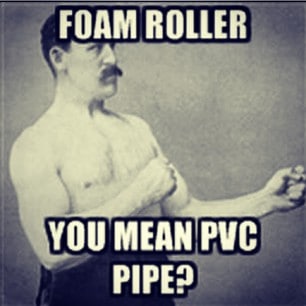Hi, my name is Michael Mash, and I’m a recovering foam roller addict. Yes, you heard me correctly. I was addicted to foam rolling, and I’m here to tell you my story…
It All Starts in High School
It was my junior year of high school when I really started hitting the weights. I was a baseball pitcher, training for the season in hopes of finally throwing over 80 mph. This is also around the same time I discovered the ingenious idea of foam rolling.
I saw others rolling muscles out on the foam roller, and I instantly just had to try it. From foam rolling their backs out to get that sought after “pop pop” in the spine, to hammering away at their IT bands because it just felt “oh so good,” I had to give it a try. And boy, I wasn’t let down!

As soon as I tried foam rolling, I was instantly hooked. There was just something about rolling out all of the “knots” in my muscles that felt so pleasing. So I started doing it before all of my workouts…because you “have to” right? Unfortunately, It wasn’t long before this spiraled out of control.
The Body is Highly Adaptable
While it was initially something I just wanted to try out, foam rolling quickly took over my workouts. Suddenly, I found myself obsessed with learning about all of the different positions I could roll out different muscles. Before I knew it, I was foam rolling for almost a half hour before even starting my workouts! Then, things took an even darker turn.

Eventually, the foam roller stopped working. It no longer gave me my fix of that “hurts so good” feeling. The pressure was no longer enough. My body had adapted!
So I did what any rational human being would do and I started rolling out on a thick PVC pipe. I just HAD to break up my adhesions! The foam roller wasn’t cutting it anymore! I kept this practice up for a few years until I had a breakthrough moment…
Foam Rolling…Doesn’t Really Do Anything Permanent?
When I started doing my own research about this subject, I came across something. It was this idea that foam rolling wasn’t actually capable of breaking up any “adhesions” or even deforming soft tissue. I was heartbroken.
It couldn’t be true! When I learned the details that it takes about 1,000 lbs. of force to even deform fascia by 1% I was shocked! Have I been wasting my time? I was confused. I was heart broken.
I sunk into denial, asking myself questions like - But it immediately felt better after I foam rolled! I couldn’t imagine doing squats without foam rolling! You have to right? If you don’t…you’ll hurt yourself, right?! Boy was I misguided…
The Truth About Foam Rolling
While my story is obviously filled with hyperbole and sarcasm, it’s unfortunately not far off from what many lifters experience. It initially starts with a few minutes of foam rolling, following by an increase in time, and eventually you find yourself rolling on a PVC pipe or rumble roller for 45 minutes prior to even touching a weight.
We now know that foam rolling doesn’t structurally change our muscles. It doesn’t break up any fascial restrictions, muscles adhesions, or any other made up terms. It simply just tells your nervous system to relax and decreases tone.
Fear Mongering the Foam Roller
Some will say that foam rolling is required in order to properly warm-up your tissues, but they are simply misguided. If foam rolling can’t structurally alter your tissues, how COULD it be necessary? Yeah, it may feel good, and create a temporary increase in range of motion or flexibility, but that’s just the thing…it’s temporary.
If you consistently need to foam roll to achieve temporarily relief from a "tight" muscle, there's most likely an underlying cause to that. Instead of putting a band-aid on the issue, seek out help to find a more permanent solution, which usually involves better load management, learning about pain, and modifying your activities!
Here’s the truth. You aren’t at an increased risk of injury if you don’t foam roll. It’s not necessary. If you do it for a few minutes prior to your workout because it makes you happy and it's part of your ritual, by all means, continue. Who am I to tell you to stop doing something that feels good?
However, if you are using the foam roller to treat pain or an injury, there are far better, more permanent ways.
Personally, when I learned it wasn’t necessary, I stopped using the foam roller as part of my warm up all together. It was tough at first, but I knew it wasn't going to negatively impact my workouts or put me at increased risk of injury..and this is what I tell my patients too.
I don’t want to create an idea of fragility. Just like your hips don't go out of place, and spinal bones don't sublux, this idea that you NEED a piece of foam to warm-up has to go!
A Better Way to Warm-Up
There is no better way to prepare for heavy lifting than to slowly ramp up the movement pattern itself. For example, I’m a firm believer that regardless of whether you squat 135 or 405 pounds, the first set of squats should always be performed with an unloaded barbell.
This is paramount to start grooving the squat pattern. One of the best warm ups for squatting...is squatting!

The key during the ramp up phase is to gradually expose your client’s body to increased loads, while minimizing fatigue to increase performance and pain-free squatting.
While slowly ramping up the intensity of the main lift may be all you need for an effective warm-up, some prefer a little more.
Enter the Dynamic Warm-Up
Now I want to be careful about swinging the pendulum too far on this one. The truth is, even with a sufficient ramp up of the main exercise of the day, it's not enough for some people. Enter the dynamic warm-up.
In a dynamic warm-up, you take your body through a series of movements to increase blood flow to the joints and muscles that you're going to train for the day. While this can technically be achieved with doing ramp up sets (like mentioned above), it's always nice to sprinkle in some other movement patterns for some variability.
Here's an example of the exercises I might do before a heavy squat session (with videos linked):
- Quadruped Hip Extension - 10 x 5" hold each leg
- Lateral Band Walking - 10 reps each way
- Reverse Lunge - 5 reps each leg
- SL Deadlift - 5 reps each
- Bodyweight Squat - 10 reps
Everyone's dynamic warm-up is going to look a little different. Regardless, it should NOT take more than 10 minutes of your time. If you find yourself needing to warm-up for more than 10 minutes prior to starting your ramp up sets, you should, again, look for more permanent solutions.
Conclusion
As a prior foam rolling addict, I can confidently say that foam rolling is NOT necessary in order to reduce the risk of injury. In fact, it doesn’t break up any adhesions or even structurally alter anything!
The immediate pain relief and increase in motion seen following this are neurological and temporary in nature. If you have a chronically "tight" muscle, seek out help to find the true cause, instead of putting a band-aid on it. Although there's nothing wrong with a few minutes of rolling if you truly enjoy it, it should not be used to treat pain or injury!

